The bug out bag is something embedded into the prepping community’s fabric. Odds are high that most survivors and preppers are either ready to go with a bug out bag or intimately aware of what one is and how to construct one.
Although it’s nice to have the requisite survival gear in a bag, what happens when you end up in a situation where you just have clothes on your back? What happens if you’re forced to abandon your bug out bag?
This is where it comes into play with a bug out bag jacket.
Why Would You Need A Bug Out Bag Jacket?
If we sit down and think about it, all of us could picture hundreds of scenarios without our bug out bags close at hand that would see us in emergency situations.
Although a bug out jacket will never replace a bug out bag, a piece of clothing that you would usually wear will provide survival gear.
Although using a jacket like this as a regular carrying item is not practical, it is something that can be kept in a car trunk, in an office drawer, or used as part of a ‘get home bag’.
Related: The Ultimate Bug Out Bag Checklist
Considerations
Before putting a bug out jacket together, several considerations must be taken.
Where this jacket is likely to see use is one of your main considerations. The basic content should remain the same, but it might be useful in an urban setting, including a prepaid ‘burner’ cellphone, some cash, a multitool, lockpicking package, handcuff key, etc., whereas if you are going to bug out through the woods, it would be a good idea to include a small fishing and trapping kit.
Next, think about your area’s year-round climate. This will decide the jacket type you are going to use with your bug out jacket.
There are several choices available, you can get a jacket that in the summer months would be comfortable and supplement it with layers in the winter months, there are also jackets available that have liners that zip out so that the insulating properties, depending on the season, can be increased and decreased.
The option I selected is to use an old military combat coat that I can wear underneath with layers and an overtop of a poncho or waterproof jacket.
Bug Out Jacket Pockets
The number of pockets is the most important thing to take into account, since that is where all the survival gear will be kept.
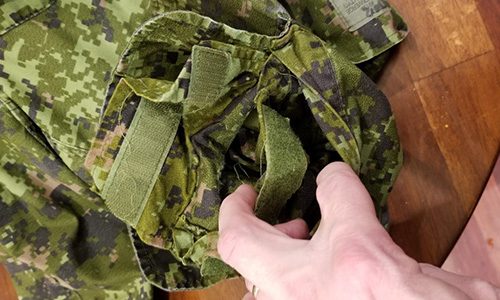

Pockets should distribute the weight of the gear equally around the torso and allow the gear to lay as flat as possible against the body.
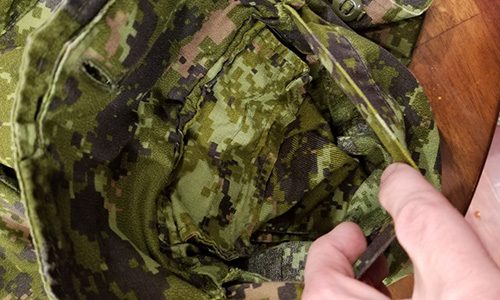

There are large external pockets in the jacket that I use which also contain smaller pockets inside that have Velcro to secure them. I prefer to use these smaller pockets to store small items inside a larger pocket full of gear that can be difficult to find.
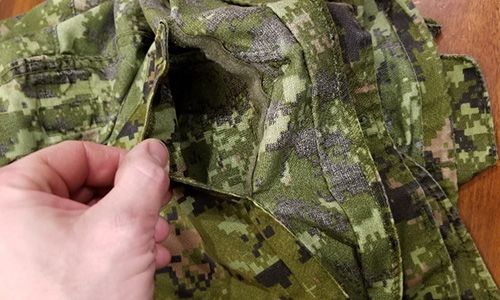

A Velcro inside pocket that is perfect for stowing a small fire kit is another feature of the jacket I’m using.
It might seem like a smart idea to have a waterproof bug out jacket when it comes to the jacket being waterproof and windproof, but the lack of breathability would make it too hot to bug out in warmer months.
It has always been my view that a much better choice is to use a thin waterproof jacket or poncho over the bug out jacket. You can find ponchos and light rain jackets that are conveniently compressed to fit into a pocket.
Related: 13 Shelters That You Can Build With A Military Poncho
Contents
Before you can reach a bug out location, cache, or your bug out bag, the content of your jacket needs to be able to provide the survival necessities. You should be able to build a shelter, make a fire, get water, and assist in other survival tasks with the equipment in your bug out jacket. Conducting the whole bug out with only the gear in your jacket should be feasible.
For this post, I made a bug-out jacket out of the jacket I wear when hunting. In no way is the list of items below intended to be a gospel list of survival items for a bug out jacket, but it does serve as a starting point in how you want your bug out jacket to be.
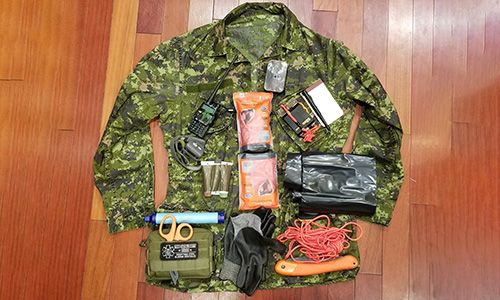

Recommended Bug Out Jacket Gear
- Shelter kit with an extra survival blanket
- Fire kit
- Small first aid kit
- Cordage
- Gloves
- Ham radio
- Notepad and Pen
- Saw
- Knife
- Life Straw
- Compass
- Headlamp
- 55-gallon contractor garbage bag
- Whistle
- Camouflage face paint
The jacket is easy to wear, even with all this survival gear.
During a bug out situation, the heaviest component with the most bulk is the first aid kit that I consider to be a vital addition because injury care can never be overlooked.
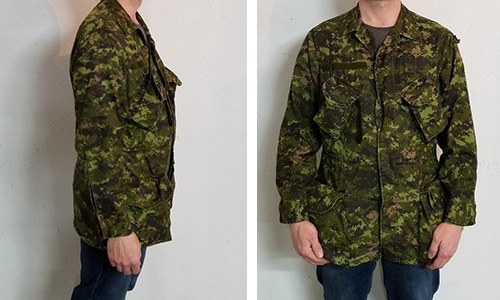

Organization
How the gear is arranged is as significant as the gear in the jacket. Anything you put in interior pockets should be gears to which you do not need regular access. Things such as a shelter kit, contractor bag, fire kits, and emergency blankets are not items to which you will need immediate access and should be put in interior pockets if possible.
Keep in mind where you can normally search for certain items while placing items in the exterior pockets. The best way to do this is to put on the jacket when it is empty and place each object in its pocket, and then simulate using the items. You can find that with a certain side, certain things such as radios are going to be better accessed and used.
If you’re bugging out with a weapon, think about what you may want to have access to when keeping the gun in your dominant hand, then make sure that you can easily access those things with your non-dominant hand.
Related: The 5 Best Pocket Handguns For Self-Defence
Adding Pockets
You might want to add some pockets to your Bug Out Jacket that can be done easily enough with simple sewing skills. There are a few things that you need to consider before you get started.
- Place them in such a way when making internal pockets that they will not add excessive bulk to the pockets on the outside.
- I prefer to purposely design them to house unique objects when it comes to pockets on the inside of a jacket. I have pinned the pocket into place for these pictures rather than stitching it.
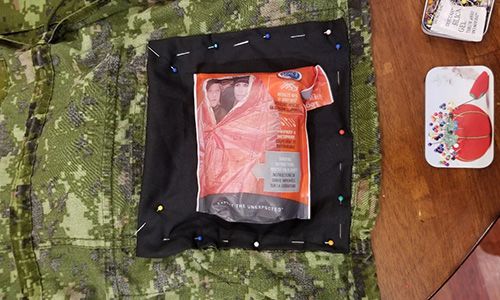

- I pin the fabric in place to create a pocket, then test it to make sure that the item fits nicely.
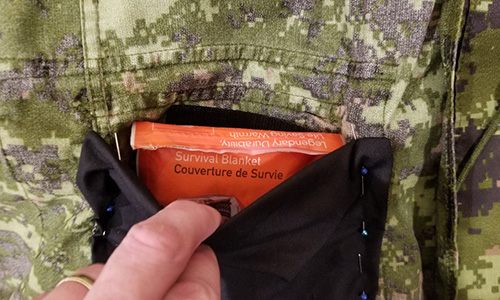

- After confirming that the item will fit well in the pocket I sew it completely and add in some Velcro to keep it closed.
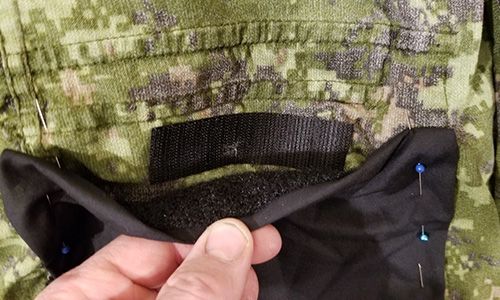

- Take your time with the stitching while attaching a pocket to the outside of the jacket, making the stitches as close as possible and reinforcing the starts and stops. Try using the same material from which the jacket is made or a similar quality material. To secure the contents with some kind of closing equipment such as a button, snaps, or velcro, the pocket will need a flap.
Concluding Thoughts
You need to be sure that not only is it going to be comfortable in every season, but that all the equipment you have inside is arranged properly if you are going to create a bug out bag jacket.
With just the jacket, it is a good idea to do a couple of practice bug-outs so that you can fine-tune the gear you plan to wear.
Keep in mind that a bug out jacket will never replace a bug out bag or a home bag and should be considered an addition to them.




















